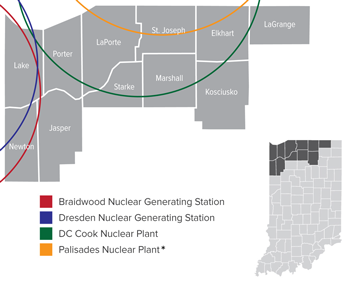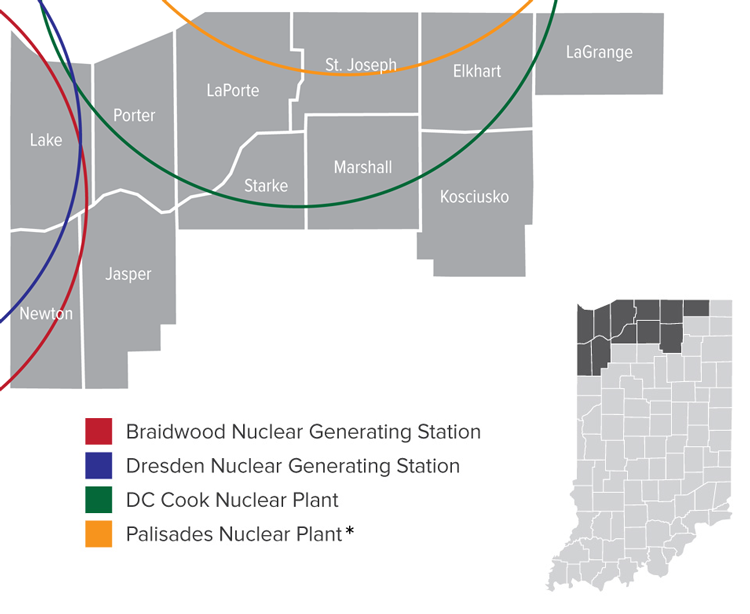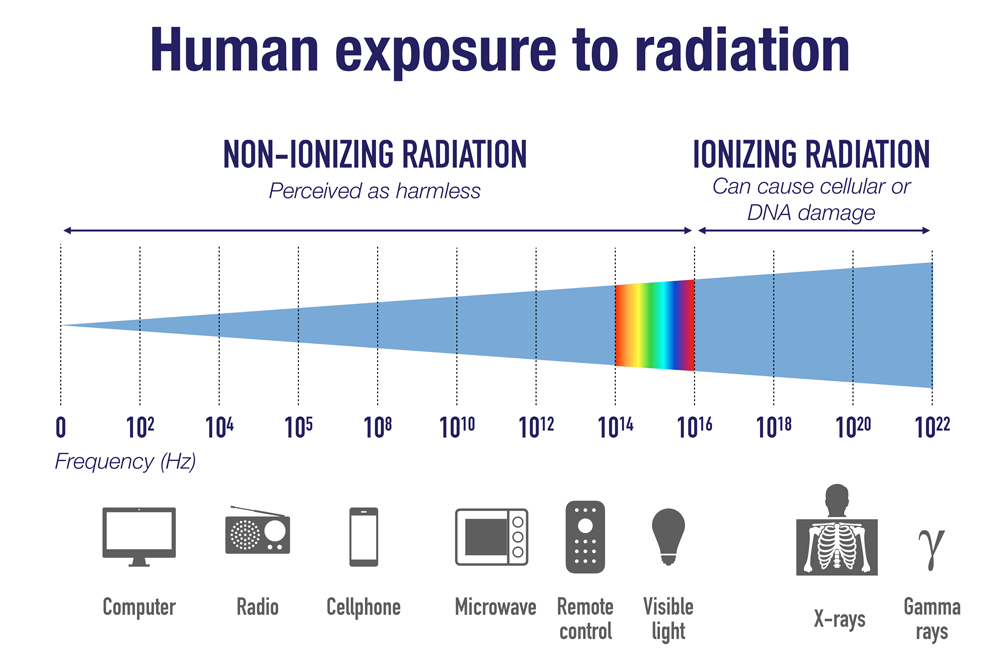
Radiation Basics
The radiation programs at IDHS oversee the transportation of all radioactive materials in Indiana and help the state and local communities prepare for potential radiological emergency situations.
What Is Radiation?
Radiation is energy. It comes from a material source as particles or electromagnetic waves. Light and heat are examples of radiation, which occurs naturally in the environment or can be created artificially. It can have either beneficial or harmful effects, depending on its use, control, levels and length of exposure.

Types of Radiation
There are two types of radiation: non-ionizing and ionizing. Non-ionizing radiation does not have enough energy to remove electrons from atoms (examples include radio waves, light and microwaves). Ionizing radiation does have enough energy to detach electrons from atoms of materials. This type can negatively affect living things as it penetrates or is absorbed by living tissue.
Radiation Uses
Radiation is used in many areas of life: medicine, academic and scientific research, industry, nuclear power production and more.
PUR-1 Research Nuclear Reactor
PUR-1 Research Nuclear Reactor
Nuclear Power Plants in Indiana
There are currently no operational nuclear power plants in Indiana. However, there has been a research and test reactor at Purdue University in West Lafayette since 1962. This reactor is one of 25 university reactors in the United States and even offers tours for the public.
Future Plants
There is renewed worldwide interest in nuclear energy as leaders look for reliable, scalable and carbon-free energy sources. Indiana is no exception: In 2022, the Indiana General Assembly passed Senate Bill 271, a law allowing and incentivizing the construction of small modular reactors (SMRs). SMRs are significantly smaller than traditional nuclear power plants, typically producing about one-third the amount power of traditional reactors.
Advantages of SMRs come from their size (small) and construction design (modular). They can be prefabricated off-site, improving quality and saving time and money spent on construction. They can also be located on sites where traditional plants could not. SMR designs use more advanced technology that may have increased safety benefits and reduced refueling requirements. SMRs would produce a maximum of 350 megawatts of electricity (may be increased, pending 2023 legislation). A megawatt of capacity may produce enough electricity to power about 400-900 homes for a year.
The Indiana Utility Regulatory Commission adopted rules in 2024 for granting permission for construction, purchase or leasing SMRs in Indiana. According to the Nuclear Energy Institute, five multiple-unit SMR plants are planned for operation within Indiana by 2035.
More on SMRs
Purdue University and Duke Energy are exploring how to use SMRs to power the university and possibly provide electricity to the state’s power grid. They hosted a series of lectures to provide more information on SMRs in 2022-2023.
Purdue SMR Nuclear Study Watch Nuclear Energy Lecture Series
Nearby Nuclear Power Plants
Across the United States, there are 92 nuclear reactors generating power to millions of homes; altogether, nuclear power is the second-leading power source used in the country at 18.2% (behind natural gas at 42.4%). Although Indiana does not have operational nuclear power plants at this time, Hoosiers should still be aware and prepared for incidents that could occur at nearby nuclear plants in Illinois and Michigan.
Ingestion Pathway Preparation and Planning
Eleven Indiana counties are within the Ingestion Pathway Zone of four commercial nuclear power plants (two in Michigan and two in Illinois). Note: The Palisades nuclear plant in Covert, Mich., was decommissioned in 2022 but is expected to restart in late 2025.
Each nuclear power plant’s Ingestion Pathway Zone is a 50-mile radius. This 50-mile radius requires specialized emergency planning. IDHS provides guidance and policies to ensure state, local and tribal governments have adequate capabilities to protect, respond to and recover from incidents involving commercial licensed nuclear power plants. The independent Nuclear Regulatory Commission is responsible for the on-site emergency preparedness at all U.S. nuclear power plants. FEMA has the lead role with off-site emergency planning and preparedness.
Nuclear Plant Profiles
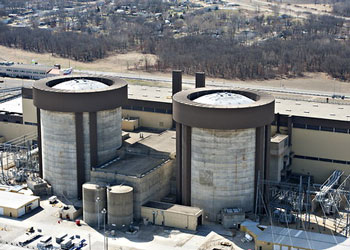
Braidwood Nuclear Generating Station, located in northeastern Illinois, provides Chicago and northern Illinois with electricity.
Government Response
Immediately following notification of an incident, Indiana public safety officials will dispatch personnel to collect samples of milk, forage, seasonal crops, processed foods, soil and water within a 50-mile radius. These samples will be analyzed to determine what areas, if any, have been contaminated and to what degree. This information will be used to determine the best course of action to protect the public and food supply. Learn more about radiological emergency preparedness by visiting the Radiological Emergency Preparedness (REP) Program page.
IDHS Radiological Emergency Preparedness Program
Personal Preparedness
Nuclear plants are built to withstand a variety of natural and severe events. Because of many safeguards and highly skilled individuals operating nuclear plants, it is very unlikely that a serious accident will occur. However, if there is an emergency situation with a nuclear plant, residents who live within 10 miles of a nuclear facility will be notified and may be instructed to shelter in place or evacuate. Emergency situations may take hours or days to develop, so there would be sufficient time for the public to take precautions. Those living farther away, such as in Indiana, should pay attention to local radio and TV stations but may not need to take protective actions. News reports will let the public know if actions are needed, and if there are instructions given, be sure to follow them.
Having a household preparedness plan in place, complete with a disaster kit, will help for many types of emergencies, including nuclear accidents.
Ask the IDHS Experts: Radiation Fact vs. Fiction
The IDHS Radiological Emergency Preparedness (REP) Program answers commonly misunderstood radiation questions below.
- Does radiation glow? Why do people think it does?

Answer:
No, radiation does not glow. The energy that is given off by radioactive materials is not visible to the human eye. There are some instances that radioactive materials can be made to glow, however, this is a result of an interaction with another material. The belief that radioactive materials glow has been manifested by TV and movies to make “radioactive materials” easily identifiable.
- Movies and TV shows depict radiation as something that will cause mutations. Is there any truth to that?
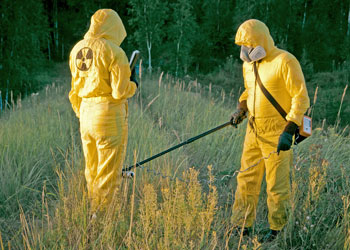
Answer:
While radiation will not give you superpowers like the Hulk or Spiderman, radiation can be harmful in large amounts. If an individual receives a large amount of radiation in a short amount of time, there may be some damage to the individual’s cells. In most cases, the body can repair the damage with no ill effects; however, if the body is unable to repair the damage, the cells may be “mutated” into cancerous cells.
- Is it true that nuclear waste cannot be safely transported?
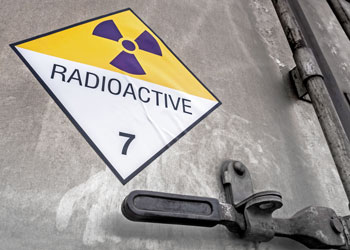
Answer:
Radiological and nuclear waste/materials can and have been shipped safely for more than 60 years. The U.S. Department of Transportation and the U.S. Nuclear Regulatory Commission test and certify robust shipping containers for the shipment of radioactive and nuclear waste/materials. The packages must be able to pass a series of test to assure their durability.
- Can a nuclear power plant explode?
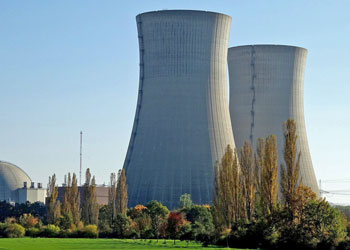
Answer:
No, a nuclear power plant reactor cannot explode like a nuclear bomb. Nuclear weapons contain special materials in particular configurations; neither of those are present in a nuclear reactor. While the only nuclear plant in the world to "explode" was Chernobyl in the Soviet Union in 1986, that type of incident occurring in the U.S. is impossible due to the design of American nuclear power plants. The tips of control rods in the U.S. are made of boron, not graphite, and all nuclear reactors are covered with a containment structure.

